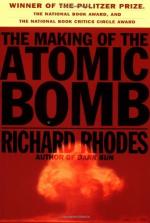|
This section contains 311 words (approx. 1 page at 400 words per page) |

|
Chapter 2 "Atoms and Void" Summary
Isaac Newton envisions atoms as small billiard balls. In 1873, the Scottish physicist James Maxwell decides atoms do not exist. By 1894, atoms are useful in chemistry to explain why certain substances (elements) combine to make other substances but cannot be broken down. Ernest Rutherford, of New Zealand, discovers radio waves in 1893 and moves to Cambridge in England to develop his findings. One month after Rutherford arrives at Cambridge, German physicist Wilhelm Roentgen discovers X-rays. Englishman J. J. Thompson discovers the electron. When electrons are stripped away from a nucleus, it leaves a massive, positively charged remainder - the proton. In 1900, Rutherford reports his discovery of a radioactive gas emanating from thorium. Marie and Pierre Curie discover that radium (purified from uranium ores) gives off a radioactive gas. In 1911, Rutherford dissects the atom. Rutherford wins the 1908 Nobel...
(read more from the Chapter 2 "Atoms and Void" Summary)
|
This section contains 311 words (approx. 1 page at 400 words per page) |

|




